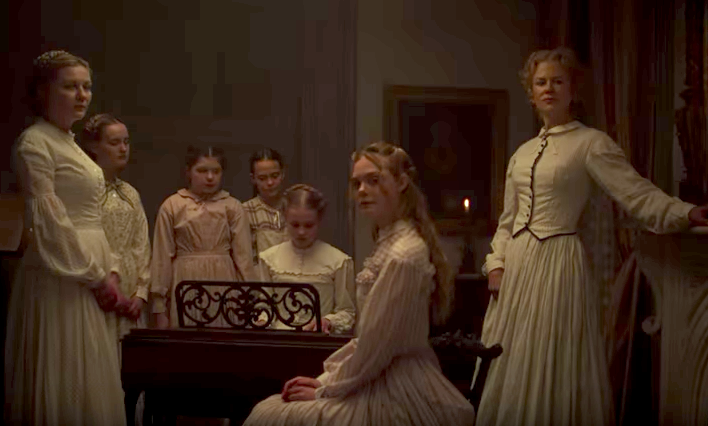By Mark Saldana
Rating: 2.5 (Out of 4 Stars)
In 1971, writer/director Don Siegel’s The Beguiled opened in theaters, but despite the critical acclaim it received, it did not do well at the box office. Siegel’s steamy and disturbing adaptation of Thomas P. Cullinan’s novel A Painted Devil came at a time where filmmakers had started getting rather gutsy with their content and didn’t shy away from depicting sex and violence more realistically. The result is a bold, subversive film that both tantalizes and shocks and features lead actor Clint Eastwood in a role atypical for him. Forty-six years later, writer/director Sofia Coppola brings her version of the Southern Gothic story; however, compared to ’71 movie, this one feels watered down and somewhat sterilized.
During the Civil War, Union soldier Corporal John McBurney (Colin Farrell) gets wounded and is unable to walk. Alone in a forest, on the verge of death, McBurney gets discovered by a young girl named Amy (Oona Laurence) who takes mercy upon him and takes her to her nearby boarding school, a Southern, all-girls seminary school run by head mistress Martha Farnsworth (Nicole Kidman) and teacher Edwina (Kirsten Dunst). Reluctant at first to help a “blue belly,” Martha and the girls decide that helping McBurney until he heals would be the Christian thing to do. Because the ladies plan to turn him over to the Confederate army once he get better, McBurney hatches a scheme to improve his chances of freedom by using his masculine charm on the ladies, but this plan eventually backfires in an ugly way.
Even though Coppola has proven herself as a talented director with such previous films as The Virgin Suicides and Lost in Translation, I feel her latest movie just doesn’t work as well as the film that inspired it. Don Siegel’s adaptation not only shows great artistry and skill in his presentation, he develops his main characters more completely with flashback cutaways and useful exposition that give audiences glimpses into their backstories. Though Coppola’s presentation is striking and gorgeous with lovely cinematography by Philippe Le Sourd and the perfect lighting and use of colors, her movie succeeds mostly on an aesthetic level and is lacking in character development.
As I stated above, Coppola takes a more restrained and sanitized approach which comes across as weak compared to the bold eroticism of the 1971 film. Her movie does have its moments of palpable sexual tension, but no real strong payoffs of either romance or sex. Siegel’s film, overall, is much more fascinating, captivating and provocative. To Coppola’s credit, she does give her female characters a more steely resolve and a less flighty quality than Siegel’s version which does feel a bit dated in this respect.
The acting by most of her actresses fit this approach well. Kirsten Dunst’s Edwina, though she has her moments of weakness, is a character that feels more steady, self-assured and less mousy than Elizabeth Hartman in the ’71 version. Nicole Kidman performs well as the strict and repressed house mistress Martha Farnsworth, but unfortunately, is restrained by the limitations of her character’s development in the script. Elle Fanning portrays the precocious and manipulative Alicia well, but she too gets restrained by the writing which removes some of the seductive boldness of the character in the original film. Colin Farrell offers a solid turn as the devious, but charming lothario John McBurney, but just doesn’t quite have the same screen presence or charisma as Clint Eastwood.
And quite frankly, this movie simply does not have the same artistic impact as Don Siegel’s version. I know that in this day and age it is more difficult to shock and disturb people; however, some of the absent elements of the original film would have still worked effectively today. Perhaps, Sofia Coppola felt that these more disturbing aspects were done in poor taste, but John McBurney is no hero. He is a downright loathsome character. This nasty behavior fits him perfectly. It also makes the climax and conclusion more satisfying. This story is supposed to be about repression, followed by the release of inhibitions and the consequences that can result. This version of the story; however, feels impeded by the filmmaker’s inhibitions.
